5 Steps to Order Your Plants
Hurry! Buying native plants takes planning and a spirit of adventure.
Dear Avant Gardener, I need to order some shrubs and plugs ASAP! Priorities are the privacy hedge along the road, perennial garden on either side of the front path, and a tick border around the yard in the back. Measuring my entire property feels overwhelmingly complicated, given the weird shape and uneven topography and various natural "features" of my land. Can you help me focus any measuring/mapping so I can quickly get to a plant plan to order the right number of plants? — Your daughter Zoe, Dutchess County, NY
Sure! And I’ll turn it into a column, of course:) I’m going to need more input from you, so let’s keep a discussion thread going. The main reason to create a master plan of the whole property is to think through how you’re going to use it — and avoid plantings you’ll regret. You’ve already tested your front yard idea by leaving leaves where you’re going to plant and raking only the turf path. How’s that working?
Fantastically! Remember how everyone used to walk past the trash cans to enter through the back door? Since I created a visible path from the driveway through the front lawn, guests use it to enter through the front door.
1. Identify sources.
That’s even better than I’d hoped. Excellent. Your biggest challenge will be finding pure species plants that fit your needs, so please look into the native plant nurseries near you (try Googling) before we start. Ask: Do they sell plugs, can you order in advance, and do they have an inventory list? Most importantly, you need to find a source for the mountain laurel and northern bayberry that will form the backbone of your privacy hedge. [See my answer to Zoe’s earlier privacy hedge question.]
What do you mean by “pure species?”
Naturally occurring plants, preferably grown from seed, rather than variations cultivated in nurseries, called “cultivars” or “nativars.” If you see a word or phrase in single quotes after the name of a plant, it’s a cultivar.
Why is that important?
Just take my word for it and avoid cultivars; I’ll explain in another column.
[A week later] Native Plant Trust’s Nasami Farm Nursery has the most comprehensive inventory of shrubs. Their inventory is online and they have some plugs. I joined so I can attend their members-only opening day on April 28. It’s two hours away, but I can make it a fun day trip.
Hmmm. Nasami’s plugs are mostly grasses, sedges, and groundcovers — and won’t be available until late-May or June. You’re going to need hundreds of plants and plugs are much less expensive than larger plants. Let’s start with Izel Native Plants, which aggregates Eastern and Midwestern growers. We can search their inventory in real time and pre-order for early May.
2. Take measurements.
For measurements, I found a plan of my lot on the Dutchess County site. Can I start there?
Yes, that’s great. Sketch in the areas you want to plant. Then measure the length and width of each.
[Days later] Voila! They aren’t to scale, but I sketched the whole property and took a lot of measurements in the snow. It wasn’t as hard as I expected.
Excellent. Questions: Why don’t the grass paths connect across the existing stone path to the front door? Also, would you consider extending the front path to continue through a meadow over the septic field? You could seed the meadow in fall. Finally, I suggest ending the tick border at the curved stone wall to keep your options open. If you extend the tick border later, you can transplant “volunteers” from the first section. (Wow, the scale for that 36-foot section in your drawing is really off, isn’t it? Perhaps redraw the map to scale so you can really get a sense of the spaces we’re creating.)
No reason re the paths; I can change that. And I love the meadow idea. Limiting the tick border is fine — although I really hate ticks.
3. Figure out how much you can handle.
The best time to plant shrubs is early fall in areas with dry summers but sufficient rainfall overall; between fall and the following spring, the young plants receive the inch of rain per week they need to establish. However, nurseries have the most inventory in spring. Are you going to be able to make sure the newly planted shrubs an inch of water a week?
We get about an inch of rain a week, as you can see from the chart below. If there’s a drought (which feels like always, everywhere these days), I can hand-water or hire someone to do it. Maybe we should only plant right in front of the house now to make watering manageable?
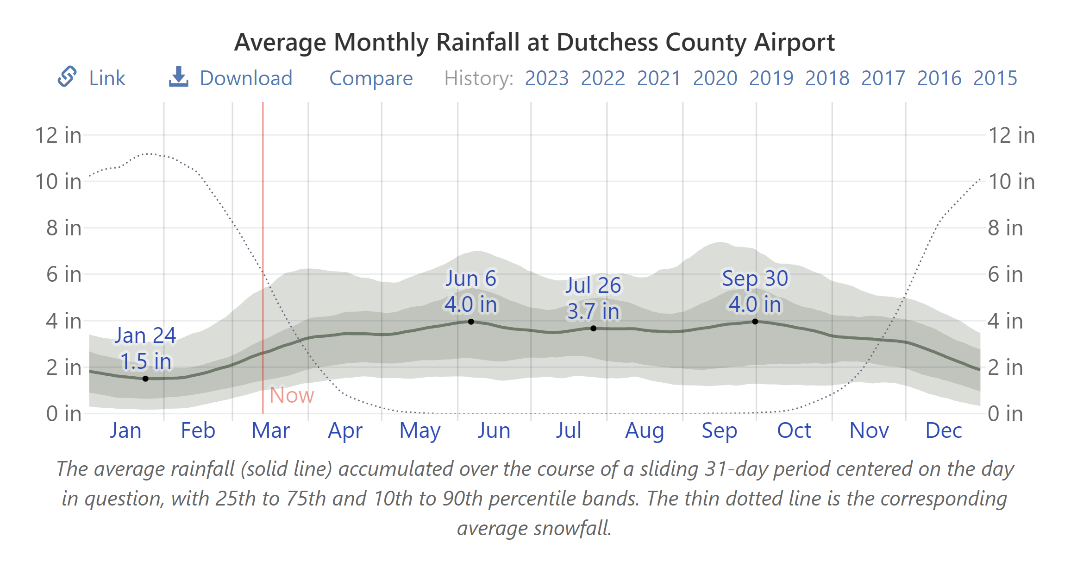
Wow, you get a lot more rain in summer in the Hudson Valley than we get in Rhode Island. Yes, I think you should limit the hedge to the front of the house. That gives you more time to figure out the south end of the property. Plus, you’ve got a ton of planting to do, even limiting the hedge length. Are you sure you can handle it?
I’m going to host a planting party! I’ll put the plants in place beforehand and my friends will put them in the ground.
4. Calculate how many plants you need.
Good idea. OK, so I marked up your sketches to show where you’re planting this spring. Here are very rough estimates of the areas — good enough for ordering:
Tick border = 6’ x 43’ = 258 SF
Sides of front path = 6’ x 60’ x 2 = 720 SF
Privacy hedge = 10’ x 70’ =700 SF
Ecological landscaping pros put one perennial plug per square foot; you might stretch it to every other square foot in the shade where you left a heavy layer of fall leaves to kill the grass. Does the math look right?
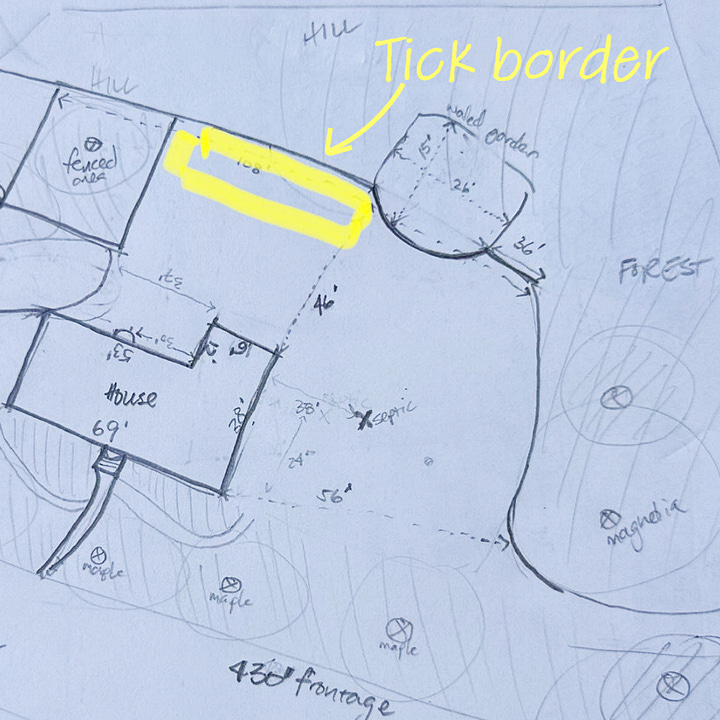
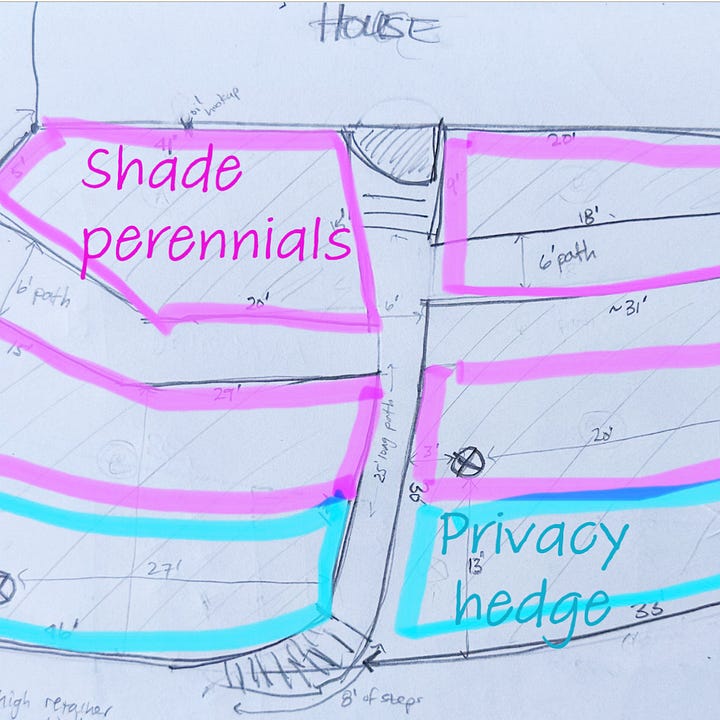
The plan looks good to me. I want as much tick protection as possible, so I’d like to stick to one plant per square foot for the tick border. I hate ticks.
You know, the tick border idea is just a theory. I’m not making any guarantees.
Did I mention I hate ticks?! It’s worth trying.
OK, try it! Plugs come in flats of 32, 50, or 72. Assuming 50, you’ll need five flats for your sunny tick garden and 14 flats for the shady areas.
5. Pick “right plant, right place” from what’s available.
Should we start with the spreadsheet of plants I’ve created based on your column?
Frankly, sweetie, many of them may not be available. I suggest you start with what Izel has that fit your parameters.
I don’t know how to start! May we meet virtually?
You’re a Community subscriber, so you’ve earned it:)
[On Google Meet, sharing screen with Izel site.] Start with “Shop by Grower.” Closer is better because the plants will have been raised — and are more likely to have evolved — in similar conditions to yours..
The two growers in Pennsylvania are closest to me. I’ll start with North Creek Nurseries. Your tick column recommended mints, monardas, and salvias. Ok, filtering for “Straight Species,” “Native to” New York, and “Light Requirement” for sun. . . .
To keep track of height and bloom time for perennials, I like to use a three-by-three grid. Like this:
So the taller plants go in back?
Yes. Or they can all be roughly the same height throughout.
[Debate ensues as we read the description of each plant, evaluating bloom time, height, color, appearance, preferred conditions, etc. We repeat the process with Kind Earth Growers. If both Pennsylvania growers have a plant she wants, Zoe puts both in her cart. She will determine which grower is best based on the potential volume discounts for the entire order; both growers offer 20 percent off for eight or more flats of plugs.]
After going through everything, we’ve got broad-leaved mountain mint and two monardas — wild bergamot and spotted bee balm. A lot is is sold out, like the salvia — maybe I should have done this in early winter like you suggested.
We need something for spring and fall. Your initial concept was all purple and white flowers. Let’s focus on purple flowers. . . .
Ok, now let’s look for shade perennials for either side of the path and around the hedge shrubs in the front. I’ll filter by “Straight Species,” “Native to” New York, and “Light Requirement” for shade. . . . Oh no, there are only eight plants available!
[After more review and debate] I adore this stonecrop, but it’s only six inches tall.
How about edging the path with stonecrop?
I love that idea! Still, we don't have 14 flats. How about using grasses – for fireflies?
And ticks?
Nooooo!
Sedges would be better in shade, anyway. But there aren’t many of those left. Why not more ferns instead?
Great idea, you know I love ferns.
You can use Native Plant Trust’s Plant Finder for ferns and summer and fall shade bloomers, then check the Nasami inventory. I’d also love to see some woodland phlox among the foamflower in spring.
For Izel, I have 250 plugs for the sunny tick border and 536 for the shady perennial garden and hedge groundcover. I got the 20 percent discount and I’m putting May 1 for the delivery date. . . . Order placed!
Now let’s talk about the shrubs.
My dinner’s ready. You already checked Nasami’s inventory for the species in my privacy hedge column. Why not just use my math to plan your purchases?
Will do. I’ll plan the planting party for the first weekend of May. Love you!
Love you!
— The Avant Gardener
P.S. If you’re a regular reader, consider upgrading to a paid subscription so I can reach more people looking for guidance to create a more ecological yard.
Why, How, Wow!
Why?
I usually devote this section to the wildlife or environmental benefits of an ecological landscape. This week, however, the “why” is joy. With an acre of woods, Zoe’s property already meets the “two thirds for the birds” threshold. Replacing the lawn around her house with native plants is largely about daily delight. The plants we’ve chosen will deliver the indescribable joy of seeing beautiful flowers and greenery abuzz with bees, birds, and butterflies each time she walks to the car or looks out her window.
How
Our selection process was pretty loosey-goosey, wasn’t it? I hope you find that freeing. Most important to garden success is choosing “right plant, right place.” We did that by filtering for plants native to Zoe’s region and light conditions, then verifying soil moisture requirements for specific plants. We considered size and bloom time in a broad sense; actual size and bloom time will depend on the plant stock and growing conditions. Eventually, Zoe can move and add to these plantings based on how they perform in her yard. This quote from Ben Vogt bears repeating:
I frankly don’t care if some of the plants die in a year or two. My goal is to pack in those plants so we can get things going. . . . Fifty percent of your plant learning comes after planting. — Ben Vogt, author of Prairie Up: An Introduction to Natural Garden Design
Wow!
Here’s how I hope Zoe’s shade garden will eventually look in the spring. At Garden in the Woods outside Boston, heartleaf foamflower blooms amid ferns and woodland phlox.
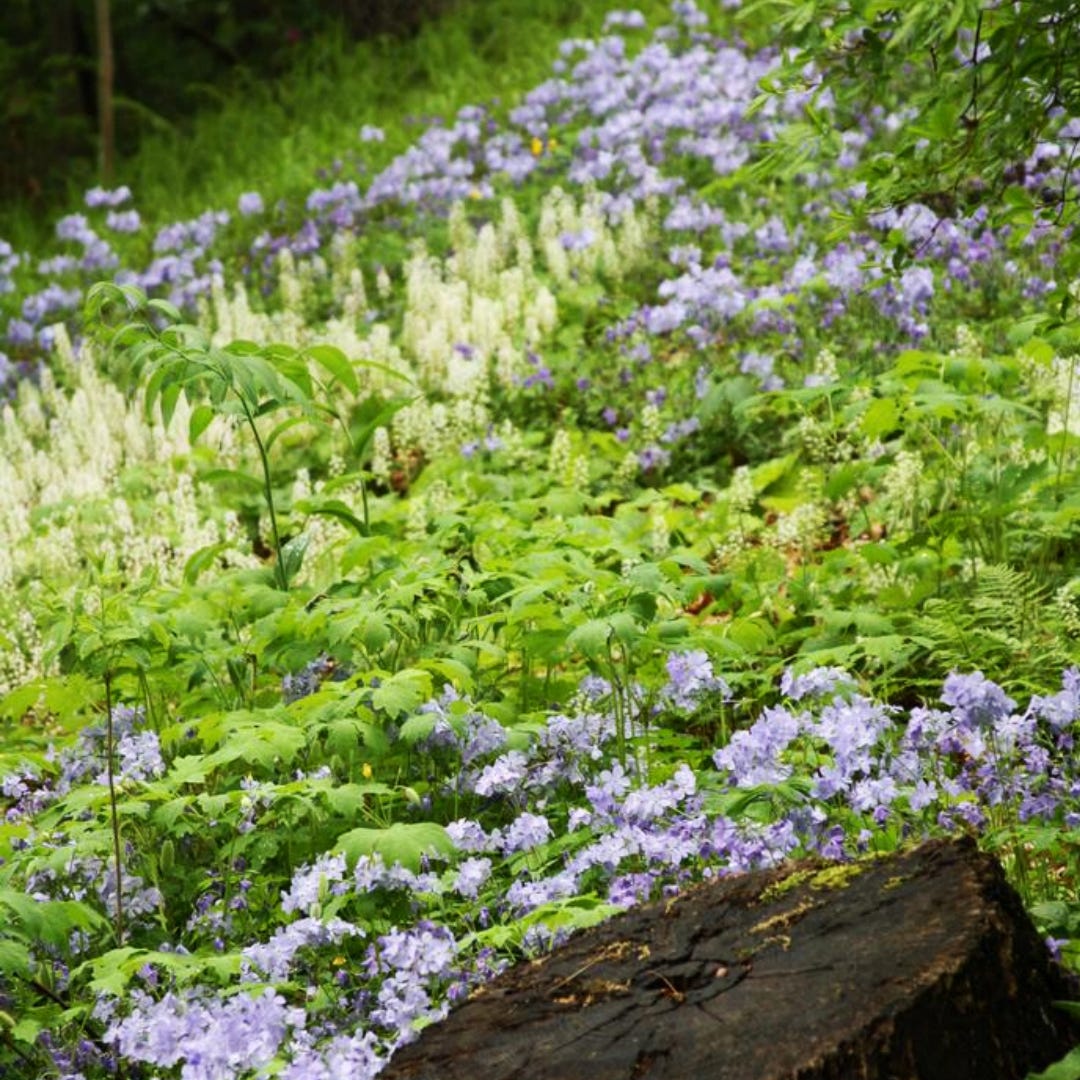
Related Resources
Impatient to know why pure species are better than cultivars? Read Wild Seed Project’s The Gardener’s Dilemma: Wild-type Plants or Nativars?
Need help with the big picture before embarking on this spring’s project? See my article, 3 Steps to a Master Plan for Your Property.




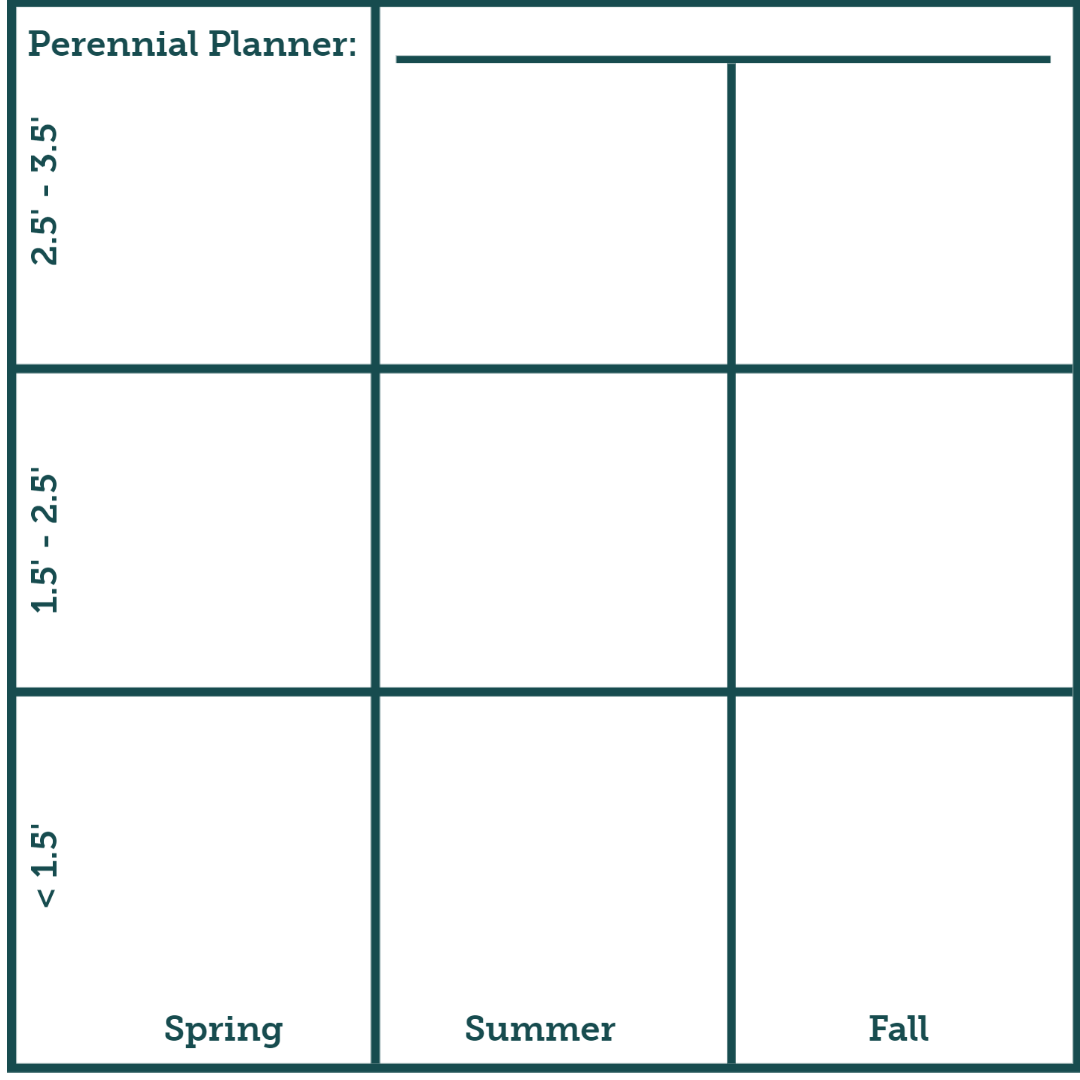
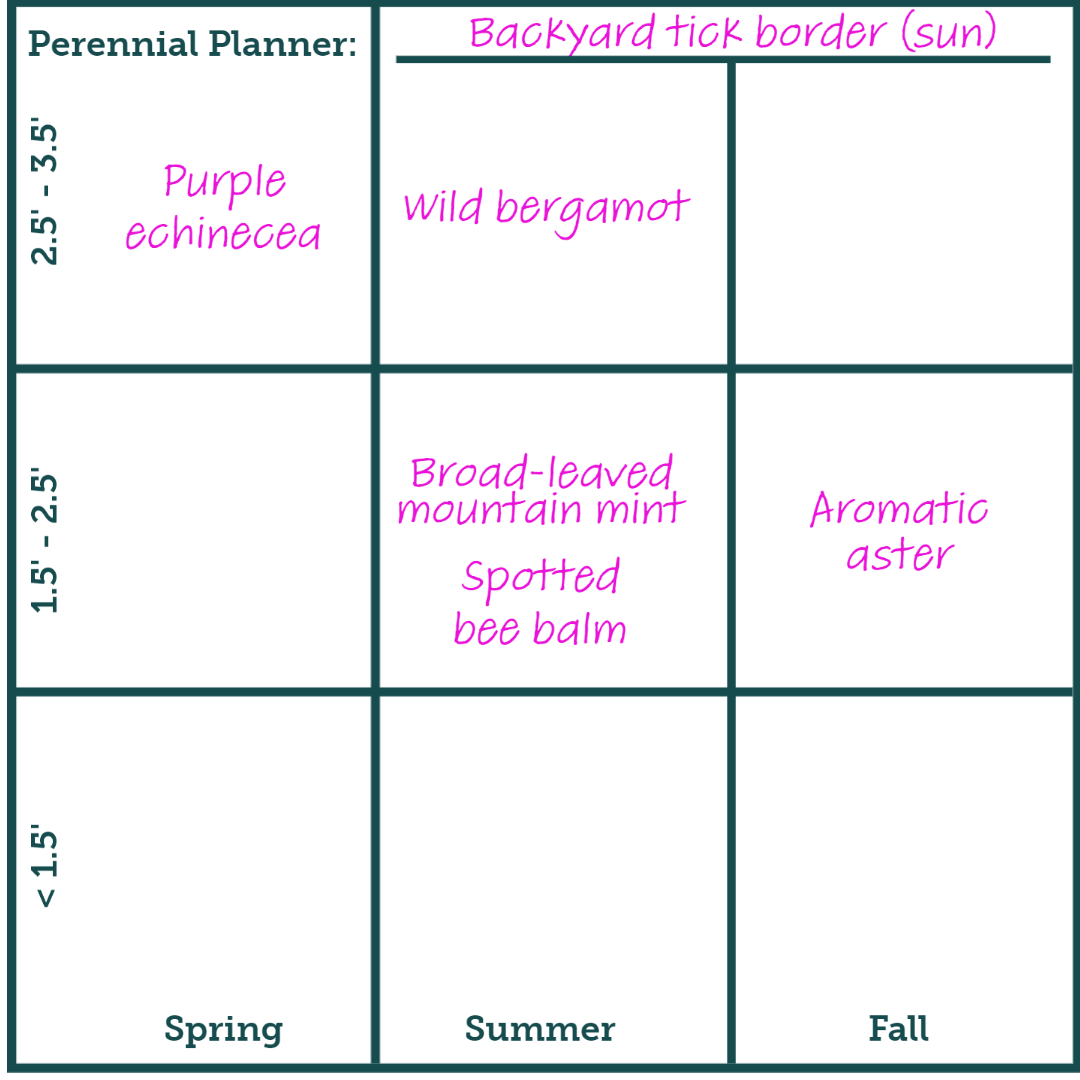
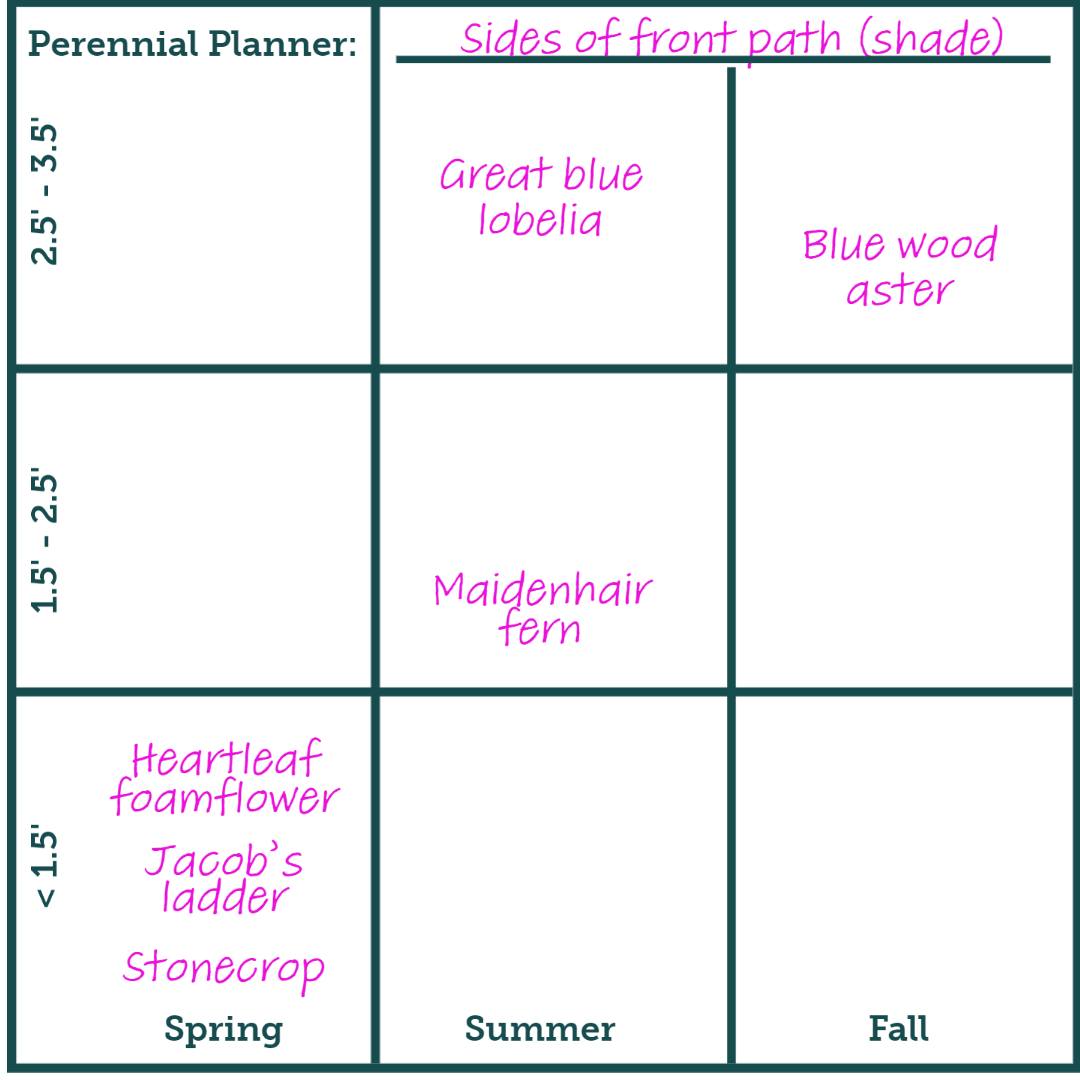
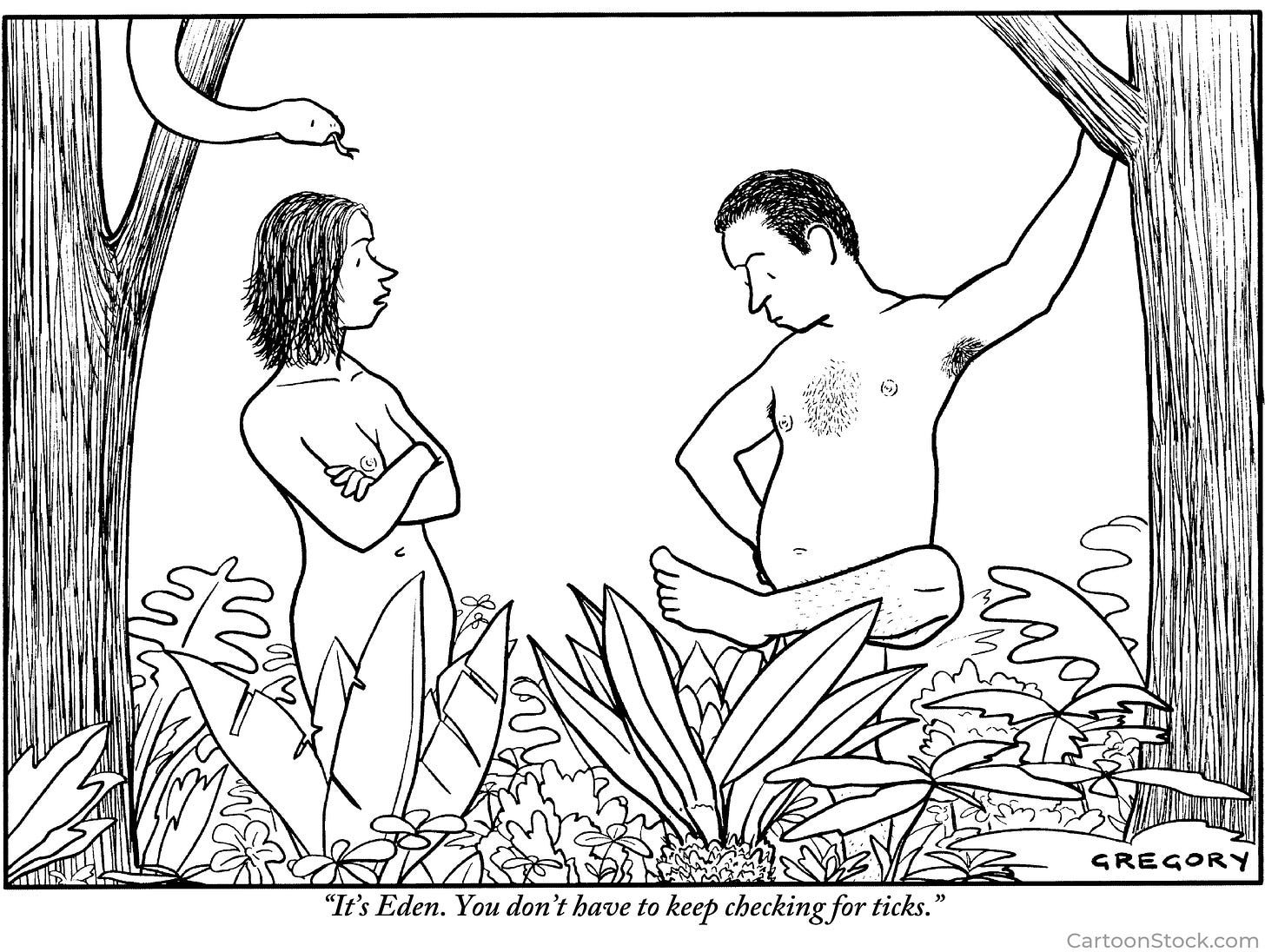
Thanks for the recent mentions! And thanks for letting us see your "process".
I wanted to let you know that our website, IzelPlants.com is currently only showing inventory that is ready to ship by our first default ship week of April 10th (orders can of course be held and shipped later). Starting on Thursday March 29th, we will be adding newly ready-to-ship crops, weekly, generally on Thursday mornings. So it’s possible that if you are seeing a species as out of stock, it may still become available this spring (or fall depending on the species) as the new crops become mature enough to ship.
You are welcome to email us a “wishlist” of species (to: hello@izelplants.com) and we can provide you the projected ready dates and take an advance order. A second option is to sign-up for the back in-stock alert at the bottom of each product page.
From subscriber email: Other retail sources with online possibilities for any future Zoe needs: thepollennation.com and pinelandsdirect.com Pinelands is almost all seed grown natives so better biodiversity. They also may have woody seed grown plants, whereas often even native woodies are vegetatively propagated so not very biodiverse.
For information on ticks/strategies to avoid, she might take a look at Kirby Stafford’s work at CT Ag Experiment station, here. Using a gravel mulch of sufficient diameter to be constantly dry in a sunny area might be a good barrier. I have found that dry laid stone walls are rodent (chipmunk especially) habitats and on properties where I have worked, that’s been a source of ticks that I try to stay aware of.
One way for Zoe to have a sense of where in her yard there tend to be ticks — or not — is to do a tick drag using white fabric (wear a Tyvek suit for this so no nymphs find you in the process!). One of my clients had a daughter with lyme disease that required antibiotics for awhile (took them awhile to realize she had Lyme) was particularly focused on landscaping to avoid ticks. We did a tick drag around the property to figure out the habitats where the ticks were heavier or lighter. We had taken a lot of leaves off the property that had accumulated over years and piled them in one place, then shredded them. That staging area had the most ticks, probably because we gathered together many too-deep leaf areas into one pile. Each yard, its conditions, presence of rodents who are often carriers, varies.
Here is an Army description of how to check an area using a tick drag (https://www.acq.osd.mil/eie/afpmb/docs/techguides/tg26.pdf). I think a combination of an observational analysis of the site for rodent presence, activity and habitat a tick drag where the drag fabric is checked near each area to try to get a sense of hot spots, and addressing any habitats near hot spots could be helpful and also add facts/awareness in an empowering way.
This warmer winter we’ve had in the Northeast favors nymphal development of ticks so don’t skip the Tyvek suit.
Another great source for plugs is PrairieNursery.com. Although they are in the Midwest, the way they create their plugs is to put seeds from a variety of ecotypes in each plug so that there is a greater change the plant will live and reproduce in the area where the plug goes. A little more expensive, but now you see why. If Midwest makes you nervous, check with them to see what they have to say about using them in Dutchess County. They are very ecologically focused. Neil Diboll had a native plant nursery long before it was cool to sell native plants.